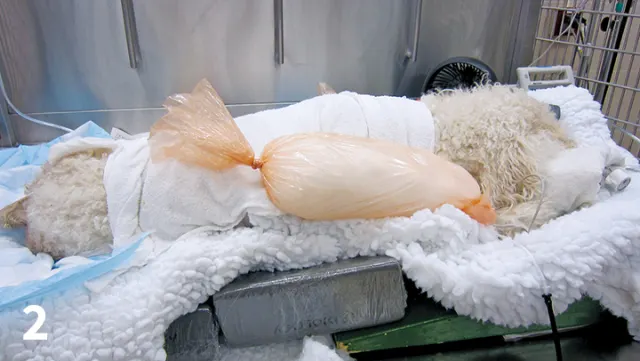Heatstroke in Dogs
Marie K. Holowaychuk, DVM, DACVECC, Reviving Veterinary Medicine, Calgary, Alberta, Canada

History
Hope, a previously healthy 3-year-old spayed pug, was presented on a hot afternoon in August after an episode of collapse.
The owners had previously taken Hope to the park and noticed she was panting excessively and became lethargic after 45 minutes. They offered her water, which she drank readily, and immediately brought her to the clinic.
Hope was up-to-date on vaccinations and had been receiving monthly parasite preventives.
Examination
At presentation, Hope was panting, had stertorous breathing, and was tachycardic (160 bpm). Physical examination showed bright red mucous membranes; capillary refill time was <1 second. Rectal temperature was 105.4F (40.8C), and oscillometric blood pressure was 100/60 mm Hg with a mean arterial pressure of 73 mm Hg.
During examination, Hope vomited water. A small amount of blood-tinged stool was noted on the rectal thermometer.
Diagnostic Evaluation
Laboratory tests performed on admission are shown in Table 1.
Laboratory Results
| BLOOD GAS ANALYSIS
pH
PCO2(mm Hg)
HCO3(mEq/L)
|
7.28
32
18.3
|
7.36-7.47
35-45
22.0-26.0
| | LACTATE (mmol/L) | 3.7 | <2 | | PCV (%) | 57 | 38-54 | | TOTAL SOLIDS (g/dL) | 8.9 | 6.0-8.0 | | BLOOD GLUCOSE (mg/dL) | 105 | 70-130 | | BUN (mg/dL) | 15-26 | <30-40 |
ASK YOURSELF
Related Article: Polling Place: The Febrile Patient: Should You Cool It?
External cooling should be implemented by owners whenever heatstroke is suspected, even before the dog is brought to the hospital. Owners can spray the dog with lukewarm (tepid) water, offer water to the dog, and drive to the clinic with the windows rolled down or the air conditioning turned on.
Studies have shown that dogs cooled by their owners before arriving at the hospital have a lower mortality rate than those whose owners do not attempt to cool.1
Owner Education
Advising owners about the risk for heatstroke during warmer months is key to preventing this serious and sometimes fatal disease.
During acclimation periods to hot and/or humid weather, dogs should not be permitted to run or play outside.
Owners should be advised that acclimation is partially complete within 10 to 20 days, but it can take up to 2 months for animals to fully acclimate to warm temperatures.6
Dogs should never be left in cars on hot days for any amount of time.
If signs of heatstroke are present, the dog should be immediately cooled and taken to a veterinarian for assessment.

A bulldog with brachycephalic obstructive airway syndrome is endotracheally intubated shortly after admission on a hot day. The dog was diagnosed with severe heatstroke.
Initial Assessment
On patient arrival, ensure the dogs airway is patent, particularly if there is history of laryngeal paralysis or brachycephalic obstructive airway syndrome. Heatstroke can be exacerbated by upper airway obstruction, and dogs that are having difficulty breathing might require rapid intubation (Figure 1).
Oxygen therapy (eg, flow-by, mask) can be initiated while an IV catheter is placed and initial laboratory work is performed. Ideally, blood and urine should be collected to obtain baseline values via CBC, serum chemistry profile, clotting times, and urinalysis.

Plastic palpation sleeves filled with ice chips are placed around a dog with heatstroke to enhance external cooling.
Cooling Methods
Dogs should be actively cooled to a rectal temperature of 103.5F (39.7C).2 If the owner has not already achieved this with external cooling methods, this can usually be accomplished by spraying the dog with lukewarm water, draping a cold and/or wet towel over the dog, and placing a fan in front of the dog. Ice packs or rectal palpation sleeves containing ice slush can also be placed in the inguinal, axillary, and neck regions (over the large central vessels; Figure 2), but should be removed if shivering occurs or after 20 minutes to avoid peripheral vasoconstriction.
Hot Weather Advisory
Heatstroke is an acute, progressive, life-threatening emergency characterized by an increase in body temperature that results in direct thermal injury to organs.
Heatstroke occurs secondary to exposure to high environmental temperatures (ie, classic heatstroke) or strenuous exercise (ie, exertional heatstroke).
Dogs that are especially prone to heatstroke include those with laryngeal paralysis, brachycephalic obstructive airway syndrome, obesity, and/or cardiovascular disease, as are older dogs or those with a dark or dense hair coat.
Ice water baths are poorly tolerated and make patient monitoring difficult; therefore, they are not recommended. NSAIDs should also be avoided because of the risk for GI complications and kidney injury. Corticosteroids have no proven benefit and are contraindicated.
Volume Resuscitation
Administration of cool (ie, refrigerated) IV fluids can improve internal cooling and help restore perfusion to organs and reduce secondary complications.2
Isotonic crystalloids (eg, Plasmalyte A, Lactated Ringer solution) should be administered in 20 mL/kg bolus volumes over 15 minutes until signs of hypovolemia (eg, hypotension, poor pulses, prolonged capillary refill time) have resolved.
Related Article: Canine Heatstroke
Management of Secondary Complications
Organ injury or failure commonly results from thermal injury, poor perfusion, and thromboembolic disease. Clinical consequences can include acute kidney or lung injury, cardiac arrhythmias, liver failure, GI signs, coagulopathies, thrombocytopenia, stuporous-to-comatose mentation, seizures, or sepsis.3,4
In severe cases of heatstroke, treatment is intensive and can include GI protectants, fresh frozen plasma, supplemental oxygen, dextrose supplementation, anti-arrhythmic medications, mannitol, and/or broad-spectrum antibiotics if sepsis is suspected.
The Take-Home
The mainstays of therapy for heatstroke patients include rapid cooling, volume replacement to optimize perfusion, and management of secondary complications.
The prognosis for heatstroke in dogs is guarded; mortality rates approach 50%, with most deaths occurring within the first 24 hours.1
The risk for death increases in dogs with azotemia, hypoglycemia, coagulopathies, seizures, and obesity, and in dogs presented to the hospital more than 90 minutes after recognition of clinical signs.1,5